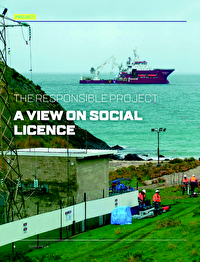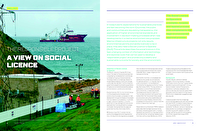Definition of Social Licence to Operate
The Social Licence to Operate (SLO) lies more in the realm of the social sciences than in engineering. Its development is attributed to the work of a group of social scientists. This body of work is increasingly relevant to the worldwide dredging industry as changes in attitudes has resulted in communities and governments expecting the willing application of higher environmental standards by owners and contractors in construction activities.
A social licence or SLO is not a formal licence. It is the acceptance by the wider public (community) of a project, a proposal or a new development through all phases of the project, from its inception to its operation. In contrast, a Legal Licence to Operate (LLO) is the attainment of required legal and institutional approvals that must be granted for a project to proceed. Having attained one, does not guarantee the other (Komnitsas, 2020).
While acquiring an SLO involves informal community engagements and negotiations, the LLOs require formal regulatory processes that include environmental approvals, various planning approvals and others that involve trade laws, labour usage, indigenous title licences and the like.
Both the SLO and the LLO processes can overlap but are usually not contradictory. For example, while an LLO may also require public consultation, it is mandated and monitored by the regulatory authority in some way (Komnistas, 2020). The requirement of consultation is one of those mechanisms within the formal LLO approval process that allows social licence to feed into it. This includes consultation with government bodies other than the consent body, as well as consultation with other stakeholders and local communities. Globally, there are many processes and many terms in use but most are similar or have similar meanings.
Respondents to an Australian CSIRO research paper described the legal licence as ‘formal permission issued by government in line with legislated requirements’ but they saw the SLO as ‘something their companies needed to earn from their communities’ (Moffat et al., 2015). Project proponents should be aware of the importance of SLO and the widespread reach of modern communication techniques such as social media.
Background
The term ‘Social Licence to Operate’ emerged in the mining industry in the late 1990s, when community trust in governments was declining and public approval in mining had plummeted in spite of the economic arguments. It came as a realisation that communities required more than government approvals to be convinced of mining’s merits. Community or ‘stakeholder’ engagement was also required.
It became evident that the increasingly environmentally aware public, with activist help, had used the SLO process to apply pressure on mining companies to lift environmental standards. The Social Licence to Operate has lately evolved into a strategic management and planning tool with respect to climate change, overfishing, pollution and a growing list of other impacts (Komnitsas, 2020; Kelly et al., 2017).
The responsible project
A ‘responsible project’ is one that is founded on sound environment science, regulatory compliance and has achieved its SLO, without suspicions of inducement. The need for both an ongoing SLO in addition to LLOs is due to a sense that responsibilities need to be shared between government and the project proponents in the face of the increasing lack of trust in governments and business (Moffat et al., 2015). This outcome to shared responsibility is ‘the responsible project’. Additionally, it is a project where there is trust that businesses operate according to their attained permits and where there is trust that the permit conditions are enforced where needed. If government is not able to enforce compliance to the environmental and social requirements, the project or activities may face a premature end.
Stakeholders
Communities, individuals and groups affected by a project, form part of a large social category called stakeholders, who either:
- have a financial interest, or will receive a reward in some way;
- are directly impacted, geographically;
- have an interest or a concern for reasons ranging from the pragmatic to the ideological; or
- are seen as important to engage around questions of social acceptability.
Nowadays, stakeholders are the product of an increasingly diverse, expanding and environmentally sophisticated population. They will grant the SLO but not necessarily with unanimous endorsement.













































